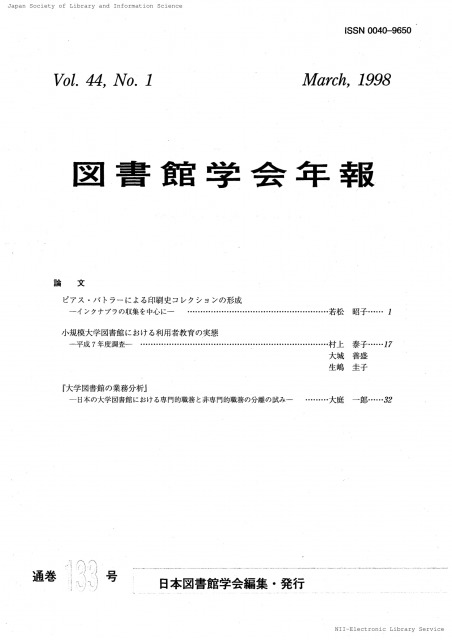All issues

Volume 36 (1990)
- Issue 4 Pages 149-
- Issue 3 Pages 97-
- Issue 2 Pages 49-
- Issue 1 Pages 1-
- Issue Supplement Page・・・
Volume 36, Issue 1
Displaying 1-5 of 5 articles from this issue
- |<
- <
- 1
- >
- >|
Article
-
Keiji OKAMURAArticle type: Article
1990Volume 36Issue 1 Pages 1-8
Published: 1990
Released on J-STAGE: November 10, 2021
JOURNAL FREE ACCESSThe South Manchuria Railway Company (SMRC), won by Japan at war with Russia, established the Information Center in April 1907. One of their jobs was colleciing books, which were available only for the research works of the Company people. This collection was the origin of the Dalian Library.
At the same time the Company built reading rooms open for the people along the railway lines, and these were the origins of “libraries along the railway lines.” From the beginning the Mantetsu (SMRC) Library had two functions or services: private and public. This dualism should be considered as the unique character of the Library in its history.
This paper describes the history of the Mantetsu Library concentrating on the accumulation of books in both the Dalian Library and the Mukden Library.
In its philosophy and activity of the accumulation of books, the reality of libraries in the Japanese colonial area in China will be revealed.View full abstractDownload PDF (1406K)
-
The Analysis and Evaluation in 1989Teruyo HORIKAWA, Bin UMINO, Masao NAGASAWA, Shinichi TODAArticle type: Article
1990Volume 36Issue 1 Pages 9-21
Published: 1990
Released on J-STAGE: November 10, 2021
JOURNAL FREE ACCESSMost of Japanese libraries publish library guides as one of user services. There are several articles on the library guide, but analytical studies are very few. So, the authors attempted to survey the current trends of library guides of Japanese university libraries in two methods; a study using questionnaire to 205 university libraries (fifty seven national universities, sixteen public universities, and one hundred and thirty two private universities) and a study using 183 library guides both in content and physical aspect.
This article consists of following chapters; (1) the data collected and methods of this survey; (2) the conditions of the editing and distribution of library guides; (3) the analysis and evaluation of physical aspect of the library guides, and (4) the analysis and evaluation of the contents of the library guides. Findings of these analyses are presented in a series of tables and discussed focusing on basic function of library guides.View full abstractDownload PDF (1656K)
-
[in Japanese]1990Volume 36Issue 1 Pages 22-27
Published: 1990
Released on J-STAGE: November 10, 2021
JOURNAL FREE ACCESSDownload PDF (819K) -
1990Volume 36Issue 1 Pages 28-46
Published: 1990
Released on J-STAGE: November 10, 2021
JOURNAL FREE ACCESSDownload PDF (2799K)
Summary
-
Article type: Summary
1990Volume 36Issue 1 Pages 47
Published: 1990
Released on J-STAGE: November 10, 2021
JOURNAL FREE ACCESSDownload PDF (70K)
- |<
- <
- 1
- >
- >|